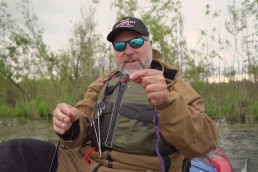Tempting Nest Protectors: Can Bass Learn Avoidance?
SHARE THIS POST
The male bass guarding his spawning bed took the job seriously by attacking the Berkley Havoc Craw Fatty I pulled into his territory. The bite was two hard, frantic tugs followed by moving the bait quickly away from the bed.
Aggressive strikes usually result in solid hookups. This time was no different. After a brief, but strong, struggle— which included two jumps—I lipped the fish, removed the hook and released it immediately.
This action took place last April in one of the numerous canals around Florida’s Harris Chain of Lakes. However, not all subsequent strikes from that bed resulted in hooked fish. Here is the whole story of how four male and one female bass used the same bed and “learned” how to lip my soft plastic bait.
The bed was located 25 feet away across the canal. It was in 18 inches of slightly stained water 12 inches in front of the sea wall—easy pitching distance. My tackle included Bass Pro Shop’s Extreme EXR70MS spinning rod, Johnny Morris JM20 spinning reel spooled with 17-pound Berkley Clear Mist Nanofil, a 17-pound-test Trilene Fluorocarbon leader, 1/8-ounce tungsten bullet weight, a red bead, Daiichi’s 4/0 Bleeding Bait Red D46Z FatGap Worm/Tube hook and Berkley’s Havoc Craw Fatty in watermelon-red flake color.
I soon discovered if the bait landed within two feet of the bed, the male would spook and not return for at least five minutes. However, if I pitched two feet farther into the neighbor’s lawn, then slowly pulled the Craw Fatty over the seawall, allowing it to splash down softly, I could pull it into the bed without spooking the bass.
Here is the catch chronology: one male bass caught five times the first three days, a different male caught four times the next three days, a female caught one time the seventh day, a male caught three times the next three days and a different male caught five times the last four days.
Each of the male bass nailed the bait aggressively twice, was caught and then released. After that, they would barely nip the Craw Fatty then move it off the bed by lipping the bait’s pincers. Repeated pitches and hooksets with the same bait resulted in tearing off the pincers, one at a time.
I missed each of the four males at least five times because they picked the bait up by the pincers instead of the body. It seemed they “learned” it was a bad thing to put the whole bait in their mouths.
Were they outsmarting me? I kept rigging a new Craw Fatty on my hook and they gripped the pincers to move it. Finally, in a moment of wisdom, it occurred to me to keep using the bait even after the pincers were gone. Maybe the bass would strike if I evoked a significant preservation response.
The solution was to pull the bait into the bed, let it sit for a minute or two and then pull it forward an inch at a time. The strikes were softer, but most of the time the fish had the whole bait in its mouth.
Are you enjoying this post?
You can be among the first to get the latest info on where to go, what to use and how to use it!
Obviously, the Craw Fatty had to appear persistent enough to eat the bass’s eggs before moving on—and that was more than the protective males would tolerate.
Did their preservation instincts cause them to ignore a smart or “learned” behavior? Buck Perry (1915-2005), “The Father of Structure Fishing,” never credited fish for being intelligent. “Their brain is smaller than a pea, and no fish has ever had an original thought,” he claimed.
If they are not inherently smart, can they learn or become conditioned?
According to Berkley’s Director of Research, Dr. Keith Jones, it is apparent they can. In his book, “Knowing Bass,” he reveals a study done with several groups of six bass each. The fish were presented with an artificial minnow bait, and within three minutes, the six fish had struck the baits an average of 24 times.
The bass were then divided into two groups and after two weeks, Group One was exposed to the same artificial minnow baits. Their response was only one-tenth of the responses of the original test. Group Two did not see the minnow baits for three months, but when exposed to them, their responses also indicated a strong negative memory of the very first experience.
Whether they learned or became conditioned is not relevant, but their response is notable. Draw your own conclusions from Dr. Jones’ tests.
Another question is what caused four males and one female bass to occupy the same bed over a 14-day period? Apparently, it does happen according to T.J. Stallings, TTI Blakemore’s National Sales Manager. “I don’t know why they do it, but it’s not unusual in our southern waters,” he said.
Are fish smart? Can they learn? Do they become suspicious of certain baits? Can they be lazy and try to reuse spawning beds?
I am not smart enough to know any of those answers but I did learn to adapt to the evolving paternal tactics of a bedding bass.
MWO
SHARE THIS POST
Did you enjoy this post?
You can be among the first to get the latest info on where to go, what to use and how to use it!
Darrell Taylor
Darrell Taylor has fished for more than 65 years. During the past 25 years, Taylor has generated more than 2,000 published articles, columns and fishing reports. His writings received 14 peer-level awards from outdoor writer organizations, including the Association of Great Lakes Outdoor Writers “Excellence in Craft” Golden Glow Award, their highest recognition.



